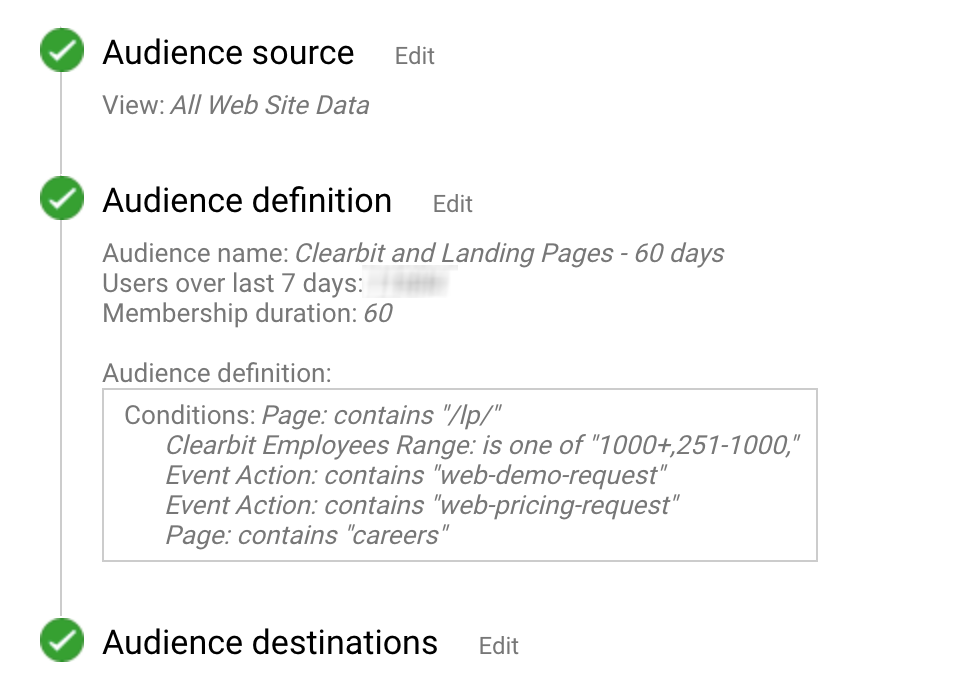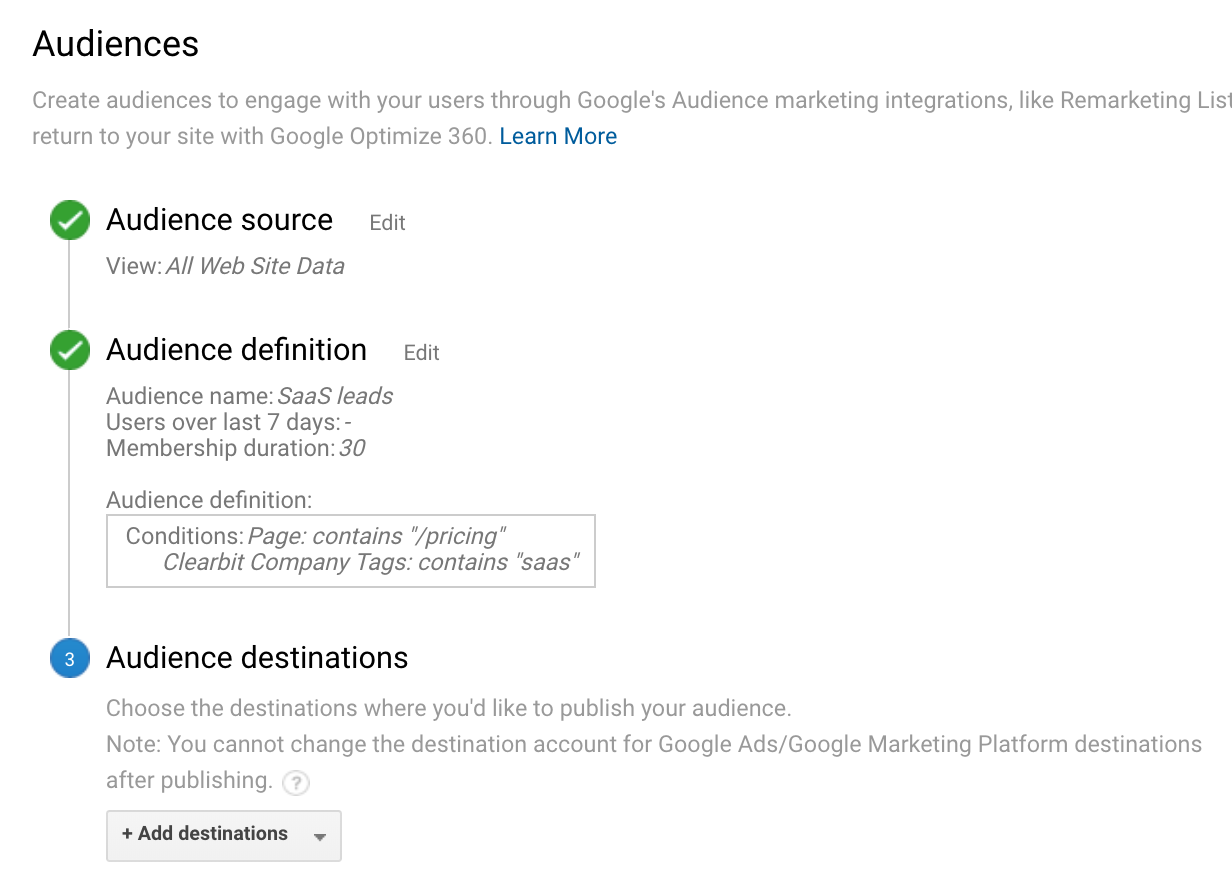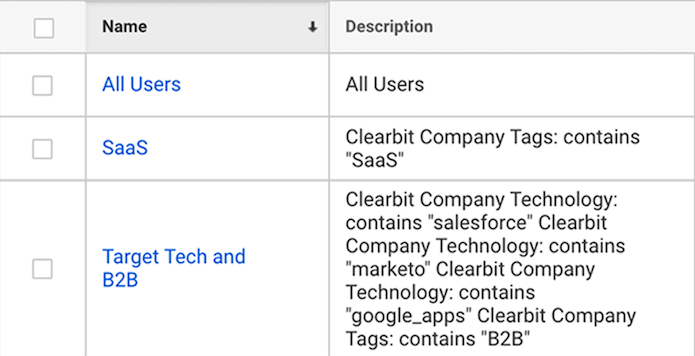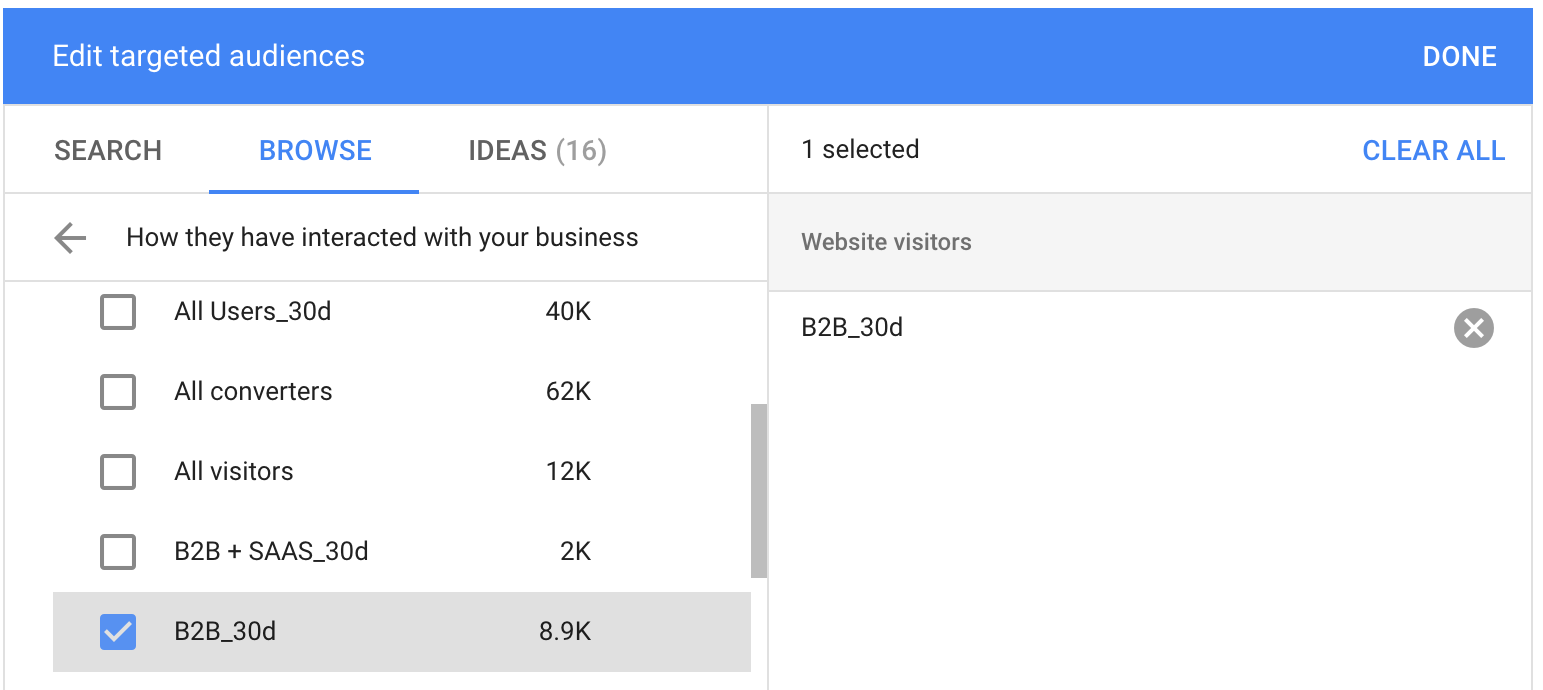How to optimize B2B retargeting with Reveal in Google Analytics
The real path someone takes through your funnel isn't linear, from point A right to point B — and most people don't sign up the first time they visit your site. They browse what you have to offer, maybe look at pricing or a few blog posts. They go away and think about it, compare you to your competitors.
Or they go away, and they don't think about you again. That path from first visit to decision time is a patchy one, full of opportunities to lose that trail of initial interest.
Retargeting allows you to keep on that trail. And unlike conventional retargeting, which is limited to what the visitor did while on your site, using Clearbit Reveal in your B2B retargeting allows you to know more about who is stopping by. With a clearer sense of audience, you can become much more intentional with your advertising budget and how you speak to that audience.
The ability to hone in on a very particular set of leads changes the retargeting game, introducing a whole new level of control and ability to personalize. For example, Outreach, a sales-engagement software, ran campaigns designed to reach only the leads who matched their target customer profile. They could invest their budget on the audience they knew to be the highest value to the business.
In this article, we'll cover how to use Reveal in Google Analytics and Google Ads to create highly personalized retargeting campaigns that are optimized for a specific set of leads, like those who fit your ideal customer profile.
What's different about retargeting with Reveal?
Retargeting with Reveal enables you to use Google Ads to strategically reengage leads based on firmographic data.
Basic retargeting is cookie-based, creating audiences based on whether they've been to your site and whether they've completed an action like a purchase or signup. Reveal provides company-level data so you can segment your retargeting audience based on more specific company information, such as the size of a visitor's company, their location, and the technology they use.
You can focus on the best leads based on granular conditions you define with that firmographic data, like those who fit your ideal customer profile (ICP). It's like pre-qualifying your retargeting audiences. The result: more personalized campaigns with more effective messaging.
 For example, you could tailor a campaign for a product demo to your best-fit leads.
For example, you could tailor a campaign for a product demo to your best-fit leads.How retargeting with Clearbit Reveal in Google Analytics works
When a lead visits your site, Reveal does a real-time lookup of their IP address and returns a company dataset of more than 50 potential data points. This information includes attributes like:
- Company name
- Number of employees
- Industry or vertical
- What technology the company uses
- Annual revenue
- Company headquarters location
This company attribute data gets passed into Google Analytics as custom dimensions — which you can use to build custom audiences that are also available in Google Ads.
So once you've set everything up, leads get automatically sorted into custom audiences — and when they fit the right conditions, automatically added to your Google Ads retargeting campaigns.
Imagine your ICP is a business with 51–250 employees that already uses Marketo, one of your key integrations. You could define an audience using these attributes and use it for your retargeting campaigns. When someone from a company who fits that profile visits your site, they'll get retargeted with your campaigns, whereas leads who don't match your ICP won't.
The optimizing power of Reveal
Retargeting is all about reaching the right audience at the right time. Lead data is a big part of that. First, these insights allow you to automatically distinguish between new leads from returning leads. Second, you can separate good-fit leads from poor-fit leads and target accordingly. As a result, you'll get:
1. More of the right leads
Not every visitor to your site is a good fit for your company. In fact, a majority of your web traffic probably isn't — which is all the more reason you need to be able to systematically target qualified leads. While in most cases, this will mean working with a smaller audience and going after fewer leads, you'll be able to spend more time, money, and effort to strategically reach the leads who matter most.
2. More higher-value conversions
You'll increase higher-value conversions since you can directly reach right-fit leads with the right information through more tailored ads. You'll have much more success reaching out to a specific target audience because your product solves their pain points. The natural product of that is a higher conversion rate.
3. Cost efficiency
A campaign that doesn't segment for target audiences is expensive and will likely have a low click-through rate and a high cost per acquisition.
Reveal prevents you from wasting ad spend on people who don't fit your ICP by retargeting only people who do. And because these people are most likely to become paying customers, they're much more likely to bring in revenue and drive a higher return on investment for your advertising campaigns.
How Outreach uses Clearbit Reveal
Outreach is the perfect example of a company using Clearbit Reveal to create more successful retargeting campaigns.
For instance, they ran a retargeting campaign in Google Ads that leveraged Clearbit Reveal data to focus on two types of companies (with 251-1000 and 1000+ employees) who visited specific landing pages. As Dan Ahmadi, who led demand gen at Outreach explains, being able to segment for things like company size means you can also adjust your bids according to the potential return. In this case, "The higher your employee range, the higher bid multiplier we set in our ad platforms."

The campaign also excluded leads already in their sales pipeline (visitors who'd already made a demo or pricing request) and companies without enough Clearbit data to determine whether they matched their target audience.
While there were fewer overall leads coming in, retargeting campaigns that used Clearbit data were 100% more effective than those that didn't. It's all-around more efficient to use Clearbit to retarget "just the right profiles", as Dan explains. "It’s a smaller audience, but it’s richer for us.”
How to set up Reveal for your Google Ads retargeting campaigns
Once you have Reveal set up in Google Analytics, you can create audiences that become available to use for retargeting in Google Ads. Here's how to do that:
Creaing a custom audience in Google Analytics
First, you'll need to create customer audiences to match your target segments. If you're targeting SaaS companies, you'll set that criteria in your audience parameters. Here, we started creating an audience for anyone from a SaaS company that visited our pricing page:

In the third step, you would choose where you want to publish your audience (your Google Analytics and/or your Ads accounts).
Create multiple audiences depending on what segments you'd like to retarget for different campaigns. For example, broad educational awareness campaigns could go to the All users segment. There could be specific SaaS-related messaging for the SaaS audience, or a campaign focusing on integrations for your B2B companies using target tech audience. We recommend blending firmographic attributes with visitor activity.

Creating a new campaign in Google Ads
Next, in Google Ads, we'll create a new campaign. Select the Display campaign type. Then, when you create your ad group, you can define your audience.

Search for the audience you created in Google Analytics. Or you can go to Browse > How they have interacted with your business > Website visitors to find the custom audiences you created.
That's it! With real-time analytics from the campaigns, you can continue to adjust your audiences to hit the sweet spot of list size and retargeting selectivity.
Reveal your audience
By concentrating your chase to just those visitors who you know are right for your company, you can make your marketing spend incredibly efficient. Over time, you can home in on exactly the right customers for you and retarget ads that speak directly to their needs, all while saving revenue.

